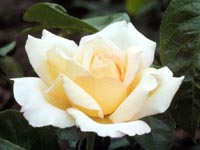Resource Library
Plant of the Week: Rose, Peace
The University of Arkansas System Division of Agriculture does not promote, support or recommend plants featured in "Plant of the Week." Please consult your local Extension office for plants suitable for your region.
Plant of the Week
Peace Rose
Latin: Rosa x hybrida 'Peace'

Roses are an enigma in the garden.
To all but the rose growing specialist, they are to be viewed from afar because their demands exceed what the average gardener can or will provide. Yet, roses remain an important ingredient that makes up the essence of what a garden is, or someday, can be. Roses also harken to another day and often have stories to tell about their beginnings or the path they followed to make a mark in the garden world. The Peace hybrid tea rose is such a plant.
The Peace rose is a vigorous hybrid tea growing up to five or six feet tall with large, leathery foliage and big multi-petaled flowers that can be up to five inches across when fully opened. The background color of the flower is various shades of light yellow suffused with pinks, which are more intense near the edge and fade away toward the base of the petal. It doesn’t have much fragrance except as it first opens.
The American Rose Society collects evaluations from its membership and ranks the garden worthiness of roses on a 1 to 10 scale, with 10 being best. The score for Peace usually is around 9, making it consistently one of the highest scoring roses. Generally any plant with a score above 8 is considered a good garden plant.
The Peace rose was introduced in the United States by Conard-Pyle of West Grove, Penn., who, in a bit of promotional patriotism, made the official debut on April 29, 1945, the day Berlin fell to Allied forces. According to legend, the budwood for the rose was smuggled out of France just before the Nazi invasion in a diplomatic pouch. The original hybrid was made in 1935 by Francis Meilland, of the famous rose breeding family near Lyon, France. Meilland, fearing the rose would be destroyed as the war raged around him, sent budwood to friends in Germany, Italy and the United States. It did well in all countries and was introduced under four different names, "Peace" in the United States, "Gloria Dei" in Germany, "Gioia" in Italy and "Mme. A. Meilland" in France. When the delegates met in San Francisco to formally establish the United Nations, the Pacific Rose Society put a Peace rose in each delegate’s room.
Growing good roses, especially hybrid teas, requires attention to detail. First, the planting site should receive at least six hours of full sun during the day. Even more sun is preferable. The soil must be very well drained or raised beds should be used. Usually roses are planted in beds with the entire planting bed worked up. The bed should be spaded to a depth of at least 12 inches and a generous portion of compost added, perhaps with a little composted manure for good measure. If lime is needed, it should be added during the soil-building phase.
Bare root rose plants should be planted as soon as possible in the spring, leaving the graft union just above the soil line. Container-grown roses can be planted until late spring.
Roses require regular fertilization to keep them growing and flowering. Following the directions recommended for one of the specialty rose fertilizers or using a general purpose garden powdered fertilizer dissolved in water is the easiest approach to feeding.
The most challenging aspect of growing hybrid tea roses is the disease, blackspot. This fungus disease attacks when the foliage first appears and can defoliate an unprotected plant by midsummer. Funginex is the recommended fungicide and it must be applied about every 10 days, or more often if it rains between applications.
By: Gerald Klingaman, retired
Extension Horticulturist - Ornamentals
Extension News - January 22, 1999
The University of Arkansas System Division of Agriculture does not maintain lists of retail outlets where these plants can be purchased. Please check your local nursery or other retail outlets to ask about the availability of these plants for your growing area.